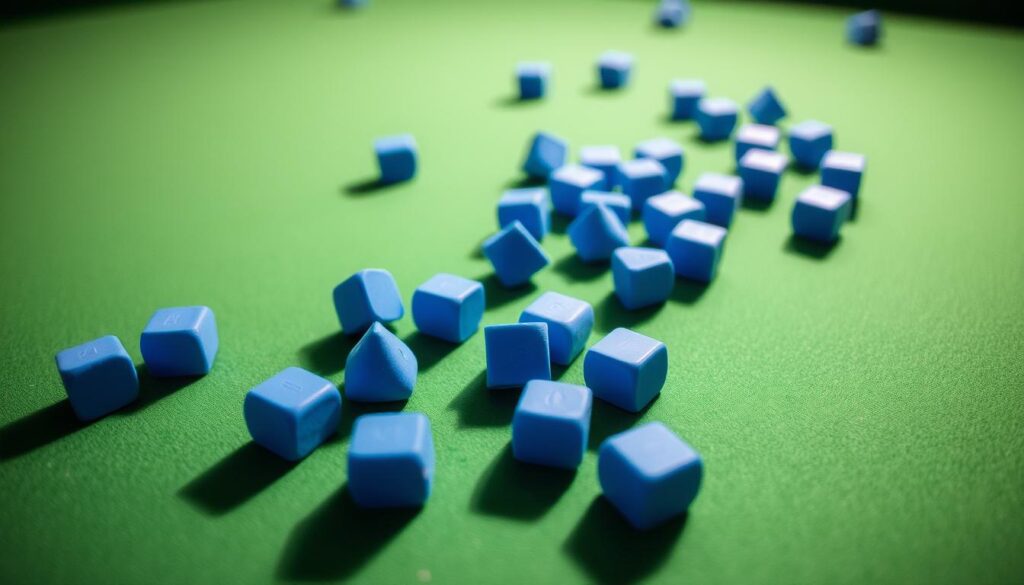Did you know 90% of pro pool players use blue chalk? This fact shows how crucial pool chalk is in cue sports. It helps with grip, spin, and avoiding mistakes. We’ll dive into pool chalk’s history, science, and why blue is the favorite color among billiards fans.

Key Takeaways
- Pool chalk is key for friction and grip on the cue tip. It lets players control the cue ball’s spin.
- Blue is the top choice for pool chalk, matching the green felt of billiard tables.
- The color of pool chalk doesn’t affect its performance. But blue is liked for being easy to see and remove.
- Good chalking technique and keeping the cue tip in shape are vital for a great game.
- Choosing the right pool chalk can really improve a player’s game and experience.
The Importance of Chalking Your Pool Cue
Preventing Slips and Improving Spin
Chalking your pool cue is key to the game. It’s not just for keeping your stick in good shape. It also boosts your game performance. When you chalk a pool cue, it makes the tip grip the cue ball better. This means you can control the ball’s spin and direction more easily.
The purpose of pool chalk is to make the cue tip’s surface rougher. This makes it easier to hold onto the cue ball. It lets you apply the right amount of force and spin, leading to more consistent shots.
Studies show that soft cue tips hold more chalk than hard tips. But, hard tips last longer. Your playing style and the quality of your cue tip will affect how often you need to chalk. You might need to chalk more or less, depending on your game.
Try different chalking frequencies to see what works for you. Top pool cue chalk brands include Master Chalk, Kamui Chalk, and Predator 1080 Pure Chalk. Each brand offers unique benefits for consistency and control.
“Chalking your cue is an essential part of the game, helping you to maintain control and consistency on the table.”
Whether you’re new to the game or have been playing for years, chalking your pool cue is vital. It helps you control your shots better. By chalking before each shot, you can avoid mistakes, improve your spin, and play better overall.
The History and Evolution of Pool Chalk
The story of pool chalk began in the early 1800s. Players first tried to keep the cue tip in contact with the ball longer. They used to twist their pool cue on plaster walls or ceilings to add grit. The plaster, made of limestone, would break down into a fine powder.
In the 1820s or 1830s, a French army captain named François Mingaud created the modern leather tip. Later, Jack Carr, a marker, improved Mingaud’s tip by chalking it. He sold his “magic twisting chalk” in powder form, marking a big step in billiard chalk history.
Over time, many pool chalk brands have come up, each with its own special formula. Brands like Triangle, Master, and Silver Cup are well-known. More recently, Kamui and Predator have become popular for their better grip and spin control.
| Chalk Brand | Key Features | Price Range |
|---|---|---|
| Triangle | Affordable, reliable chalk | $1.50 – $3.00 |
| Kamui | High-quality, consistent grip, available in different colors | $6.00 – $8.00 |
| Predator | Excellent grip and accuracy, premium quality | $5.00 – $7.00 |
| Russian Magic Chalk | Reduced residue, longer-lasting, variety of colors | $4.00 – $6.00 |
The journey of pool chalk has kept going, with new things like liquid chalk. Brands like Taom, Balabushka, and Chalkmaster have come up with special formulas. These offer better grip, spin, and less residue. As pool and billiards have grown, so has the need for the right pool cue chalk to play well.
“The story of pool chalk is a fascinating glimpse into the rich history and evolution of this essential accessory for the game of billiards.”
The Legendary Story of Jack Carr and His “Magic Twisting Chalk”
In the world of billiards, a legendary tale has captured players for generations. It’s about Jack Carr and his “magic twisting chalk.” The story says Carr’s secret was in the packaging, not the chalk itself.
His product was just calcium carbonate, like most pool chalks. But Carr had a smart marketing plan. He named it “magic twisting chalk” and made it blue.
This simple change was key to his success. The blue color is still seen in many pool chalks today. It shows Carr’s lasting impact.
The true story of blue pool chalk is still a mystery. The first record of Carr’s chalk was in 1858, but it didn’t mention the color. Some think Carr used regular white chalk and the blue was just a marketing trick.
Whether Carr’s chalk was truly magical is still debated. But one thing is clear. His clever branding and the blue color have shaped the pool chalk industry forever.
The Science Behind Pool Chalk
Understanding the Composition and Properties
Pool chalk comes in many colors, like blue, pink, and green. You might wonder what it’s made of and how it’s different from regular chalk. Let’s explore the science behind pool chalk and its special properties.
Pool chalk is mainly made of silica, a mineral that’s gritty. It also has aluminum oxide and corundum mixed in. The silica helps the chalk grip your cue tip well, allowing for precise shots.
Pool chalk is not like regular chalk, which can be soft and powdery. It’s made to last longer on your cue tip. This means you don’t need to re-chalk as often, keeping your game consistent.
| Ingredient | Purpose |
|---|---|
| Silica | Provides the gritty texture essential for grip and spin |
| Aluminum Oxide | Contributes to the chalk’s durability and longevity |
| Corundum | Enhances the chalk’s ability to adhere to the cue tip |
The colors of pool chalk, like blue, are mostly for looks. They don’t really change how the chalk works. But, they can make your pool table look nicer by matching the chalk to the table’s color.
Knowing how pool chalk works helps you choose the best one for your game. This ensures you have a smooth and consistent play every time you play.
does pool chalk color matter, what does pool chalk do,why is pool chalk blue
Pool chalk color might seem minor, but it’s crucial for your game. White chalk gets messy, so colors like blue are used. Blue chalk is popular for good reasons.
Pool chalk’s main job is to help you grip and spin the cue ball. But colored chalk, like blue, blends well with the green table. This makes it easier to see and clean up. Blue chalk stands out nicely against the table’s felt.
Blue chalk’s fame comes from Jack Carr’s “magic twisting chalk.” It was said to improve spin and control. This made blue chalk a favorite among pros, making it the top choice in the pool world.
While blue chalk looks good, its main goal is to enhance your game. Whether you pick blue, green, or another color, the key is consistent cue ball control. This reduces mistakes and boosts your performance.
“The color of pool chalk may not matter, but the way it performs on the table is what really counts.”
Your choice of pool chalk color depends on what you like and what suits your style. But, the most important thing is to use quality chalk. It should help you stay in control and confident in your shots.
Choosing the Right Chalk for Your Game
As a pool enthusiast, picking the right pool chalk is key. The best pool chalk is made for pool tables, giving better grip and consistency than regular chalk. Each pool chalk color helps improve your cue’s grip and your game.
There are many pool chalk types to choose from. Standard chalk is the most common and cheap, good for casual players. Master chalk is a favorite among intermediate players, offering great value. For serious players, premium pool chalk brands like Kamui are the best, providing top-notch consistency and control.
- Standard chalk: The most common and affordable option for billiards players.
- Master chalk: A preferred choice among intermediate players, balancing performance and affordability.
- Kamui chalk: The premium choice, preferred by serious players for its exceptional consistency and improved control.
The right pool chalk depends on your skill, preferences, and play style. While high-quality pool chalk may be pricier, it offers better consistency, less residue, and improved play. It’s a smart choice for serious players.
“The right chalk can improve overall gameplay by enhancing cue ball control, reducing miscues, and boosting player confidence on the billiards table.”
Proper Chalking Technique
Applying pool cue chalk is key for any billiards fan. It helps with grip, spin, and control of the cue ball. Here’s how to chalk your cue right:
Guidelines for Applying Chalk Effectively
- Choose the right chalk. Go for high-quality pool cue chalk like Taom, Kamui, or Predator. Regular chalk won’t do the job.
- Apply the chalk evenly. Rub it on the cue tip in circles for a light coat. Make sure it doesn’t get on the shaft or table.
- Use the right amount. Too much chalk messes up the table and hurts control. Start small and add more if needed.
- Chalk before every shot. This keeps your performance steady throughout the game.
- Avoid standing near the table when chalking. This keeps the table clean and prevents miscues.
By following these tips, you’ll chalk your pool cue effectively. This will boost your grip, spin, and control. Learning to chalk your pool cue well will elevate your game and make you more confident.
“Proper chalking technique is the foundation of accurate and consistent shot-making in billiards. It’s a simple yet essential skill that every player should master.”
Maintaining and Cleaning Your Pool Cue
Keeping your pool cue in top shape is key for great play. If you’ve used too much pool cue chalk or just want a clean cue, proper care is essential.
Remember, the tip of your cue should never get wet. Using a wet wipe on the cue end can make the chalk dust useless. Instead, use a damp cloth to wipe the shaft, avoiding the cue tip.
For a deeper clean, a damp magic eraser or fine-grit sandpaper can help. But use these gently, as they can wear down the cue. You want to remove extra chalk without harming the cue.
- Avoid getting the cue tip wet to prevent chalk buildup
- Wipe down the shaft with a damp cloth to remove excess chalk
- Use a damp magic eraser or fine-grit sandpaper for a deeper clean, but do so sparingly
By following these easy pool cue maintenance tips, your cue will stay in great condition. This ensures it will perform well for many years.
Conclusion
Cue chalk is key to a better pool game. I always chalk up before each shot to avoid mistakes. Some players chalk up after every other shot, but I do it before each one.
The right amount of chalk depends on your cue’s hardness. Softer cues need more chalk than harder ones. Keeping your cue clean and well-maintained can also boost your game.
As an intermediate player, I’ve seen a big difference with premium chalk like Kamui Chalk. High-end chalk brands help me make fewer mistakes and hit my targets better. Also, taking care of my chalk makes it last longer.
Chalk is very important in pool. Knowing how to use it has improved my game a lot. Whether you’re new or experienced, using chalk right can make a huge difference. It helps you aim better and enjoy the game more.

